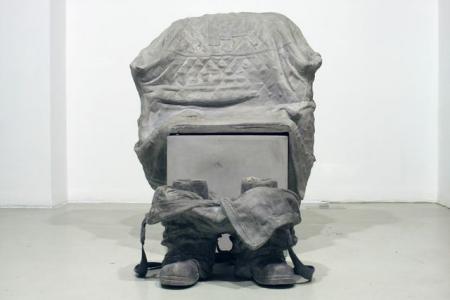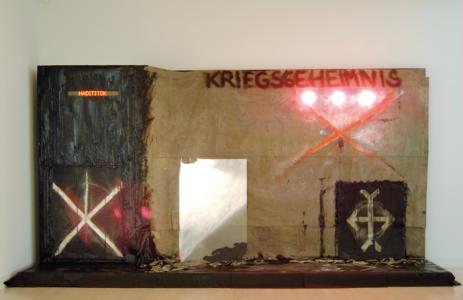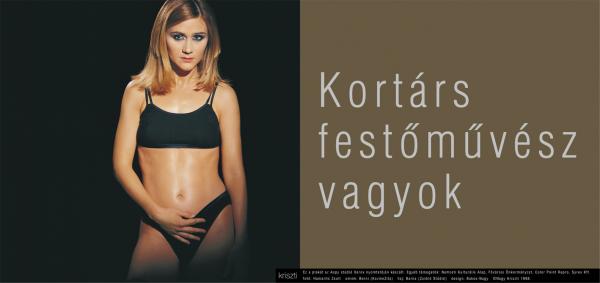Unmistakable Sentences
The exhibition titled Unmistakable Sentences puts new pieces of Ludwig Museum's permanent collection on display. Even its title is provoking by miming unambiguity, but in reality it calls for (mis)understanding, thinking. As curator Katalin Tímár says: "it builds on the active involvement of the audience in a big way, making them use their own personal experiences, knowledge to interpret the works, thus creating a relation with it that is much more personal".
The pieces exhibited mostly deal with Central European and Hungarian issues but questions regarding global problems and the ontology of art also arise as well as works that try to react to the theme of 'absence-presence'. The collection aims at the free revision of the era from the late fifties to today with works concerning social, cultural, political, artistic phenomena. Despite the categorizability of the works on display, they aren't organizied in halls by topic but scattered around, making the works themselves have conversations of their own, and it's up to the visitor if they can create a personal bond with the pieces or not.

Upon entering, the first work you see is István Csákány's installation titled "The Worker of Tomorrow, Service-Uniform" (2009). The piece depicts a firefighter's uniform taken off during service, missing its owner. This picked out moment shows how saturated absence really is. Beáta Veszely's large red pillow 'taken' from the bed of Jan van Eyck's Arnolfini portrait, plays with focusing on a certain detail to question the canonised interpretation and relocate the emphasis. And maybe it is this 'taking', 'copying', 'relocating' that has the key role; every piece directs your attention to the deepness and complexity of the theme through stressing a small detail. Tibor Hajas' photo action art "To the Streets with Your Message" (1975) is one such work, evoking the reality of socialist Hungary by writing messages on the walls of public facilities to reflect upon the censoring of letters sent abroad. Miklós Erdély's "Military Secret" (1984) aims at broadening the meaning of the word 'secret' by thematizing military and political secrets related to governing systems of all time. He expands his work with 29 explanations like "Present – Military Secret; Absent – Military Secret; Solace – Military Secret; Possible – Military Secret" etc.

The photograph of Zbigniew Libera's "Lego. Concentration Camp" (1996) reflects on the Nazi Holocaust. It features a miniature concentration camp made of Lego pieces. In the background, there is of course the cliché of using good things the wrong way but this is an absolutely new perspective on how scientific achievements were used to operate Nazi death camps also seen as the overgrowth of rationalism. Drawing a parallel between cruelty and a toy concentration camp made of Lego pieces reflects the present time as well as history by focusing on the pieces.
Being an artist is an existential problem that is inseparable of political systems and is defenseless against them. Kriszta Nagy's poster "I am a Contemporary Painter" tries to wake 'todays Hungarian reality' by posing in underwear to advertise herself. It is interesting to compare this work to "Artist at Work" (1978) by Mladen Stilinovic which is a series of photographs depicting the agony of a bearded man laying in bed. The world of art is inseparable of the artist's life and the place where art takes place. Originally a piece of the exhibition organised to protest against the closing of Dorottya Gallery, Csaba Nemes' painting shows this through presenting the building in an evening glow.

The above are only examples but they show the numerous attitudes and techniques that are featured in this 'revistied collecion'. And just as the exhibition allows for the dialogue between the works, so should you embrace the current of 'revisiting'. The exhibition aims at outlining relations that allow us to get closer to each other, to art, to our world and to the understanding and interpretation of our cultural and political past. It's only up to us if we become "actively involved" in an exhibition beyond time and space.
Unmistakable Sentences. The Collection Revisited – Ludwig Museum
Open from May 26, 2010 to August 14, 2011.
Exhibiting artists:
Exhibiting artists: Gábor Bachman, Imre Bak, Bik Van der Pol, Ákos Birkás, Rafał Bujnowski, István Csákány, Miklós Erdély, Marcell Esterházy, Richard Estes, Semyon Natanovich Faibisovich, Harun Farocki, László Fehér, Ferenc Ficzek, Andreas Fogarasi, Tibor Gyenis, Tibor Hajas, Károly Halász, Impex – Workshopron, Irwin, György Jovánovics, Zsigmond Károlyi, Tamás Kaszás, Tamás Kaszás – Gábor Kerekes – Gergő Kovách, Zsolt Keserue, Kis Varsó / Little Warsaw, Ádám Kokesch, Stanislav Kolíbal, László Lakner, András Lengyel, Zbigniew Libera, Rebecca Major, David Maljković, Dóra Maurer, Malcolm Morley, Antoni Muntadas, Kriszta Nagy, Csaba Nemes, Sándor Pinczehelyi, Gerhard Richter, Simon Starling, Henryk Stażewski, Frank Stella, Mladen Stilinović, János Sugár, Sean Snyder, Bálint Szombathy, Timm Ulrichs, Endre Tót, Goran Trbuljak, Gyula Várnai, Beáta Veszely, Imre Weber
Curator: Katalin Timár
Financial support: Peter und Irene Ludwig Stiftung, Aachen; National Cultural Fund; Ministry of Education



Facebook-hozzászólások